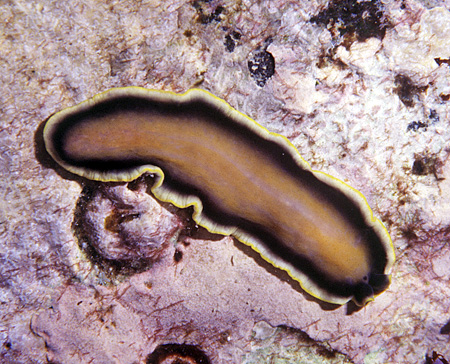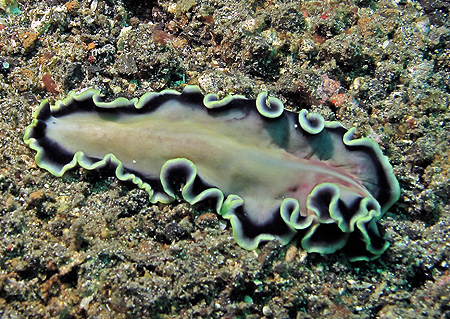|
Pseudoceros
jebborum Newman & Cannon 1994 Unfortunately, the "cream-orange" or caramel-colored central band (shown in the photo below) is sometimes almost white (according to photos on the 2004 Newman & Cannon CD). A worm with a white central band would be hard to distinguish visually from the similar "Gold Rim Flatworm" Pseudoceros paralaticlavus. To complicate matters, it seems that the latter species sometimes also exhibits a caramel-colored central band. Cory Pittman raises the possibility that this coloration may be due to a covering of pigmented mucus sometimes, but not always, secreted by each of these two closely related worms. Cory goes on to suggest, tentatively, that a better character for separating the two species might be the relative widths of the central bands, measured when the worms are crawling. In jebborum the central band is wide, about 1/2 to 3/4 of the animal's total width, whereas in paralaticlavus the central band is narrower, about 1/4 to 1/3 the animal's width. **see below Another character might be size: according to Newman & Cannon, jebborum grows longer than paralaticlavus: 2.75 in. (70 mm) vs. 2 in. (50 mm) respectively. P. jebborum
is found from the Western Indian Ocean to the Hawaii.
However, it seems to be quite rare in Hawaii. The issue of whether
P. paralaticlavus is just another color form of P. jebborum
was examined in a 1996
paper by Coggin and Newman, which showed a 6% difference between
the DNA of allopatric specimens. An
entire web page is devoted to the difficulties of separating the
two species visually. |
 pigmented |
 not pigmented Bernard Dupont, Wikimedia |
|
-------------------------------------------------------------------------------------------------------------- -------------------------------------------------------------------------------------------------------------- |
|
Pseudoceros paralaticlavus: "Central band about 1/4 to 1/3 animal's width when crawling; pigment, when present, confined to central band and light orange-brown in hue; pigmented mucus shed in relatively large, random patches; continuous marginal yellow line present; lighter line in middle of central band usually (but not always) present." |
hawaiisfishes.com